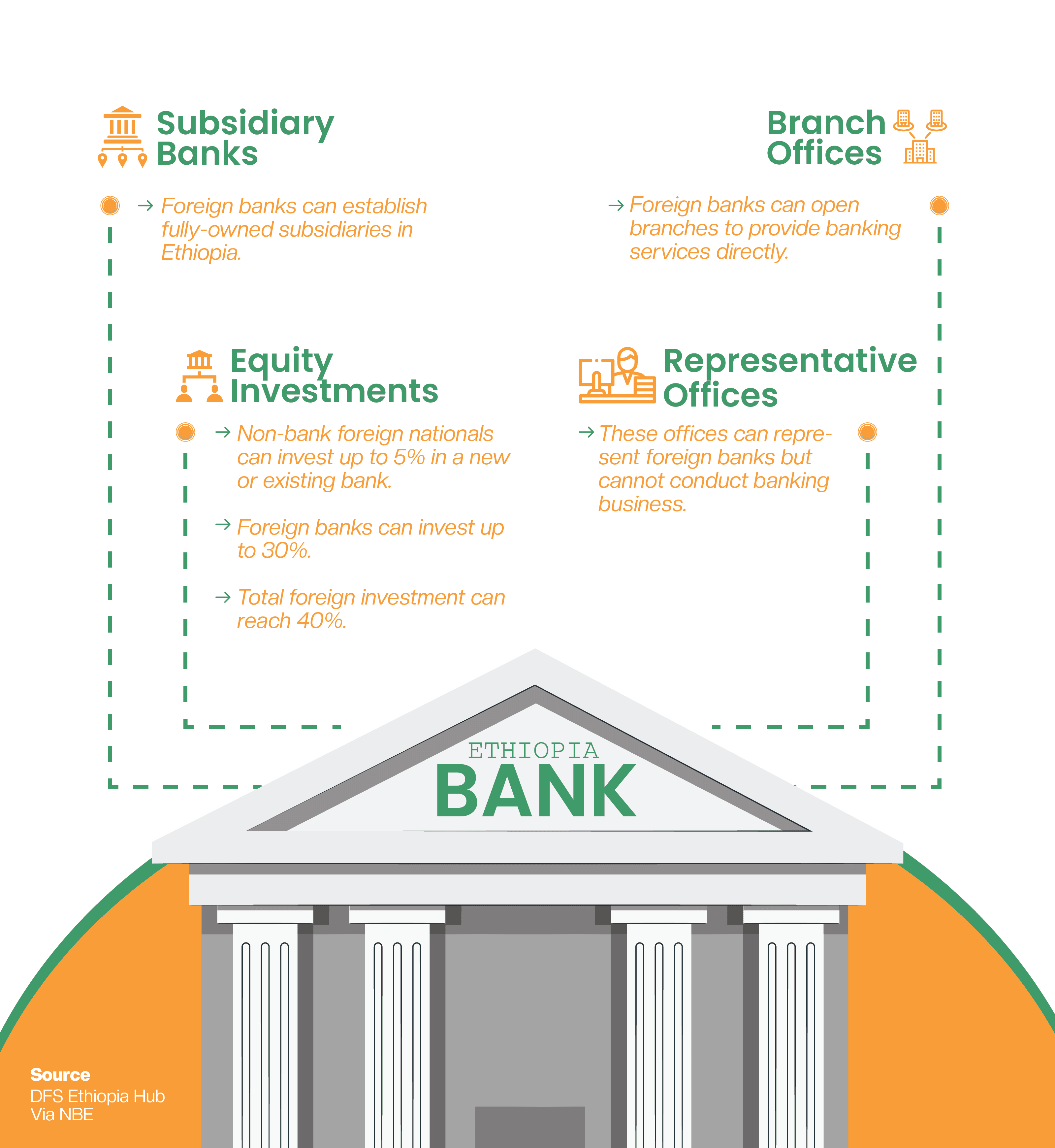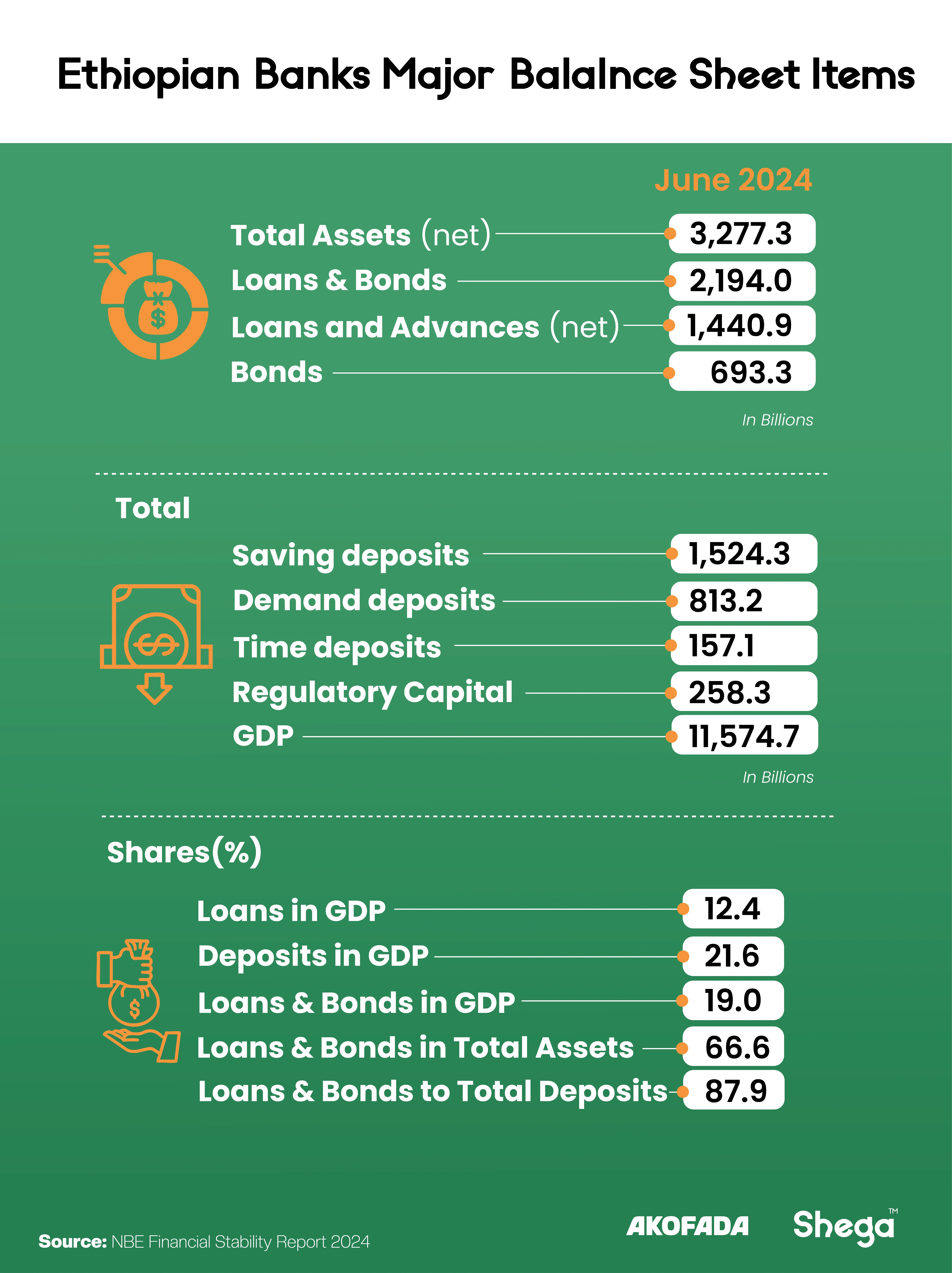Progress for 0 ad
Progress for 1 ad
Progress for 2 ad
Progress for 3 ad


Munir Shemsu
Addis Ababa, Ethiopia

When foreign banks enter Ethiopia’s financial sector, their influence on financial inclusion and the sector’s development will likely depend on the quality and scope of digital financial services (DFS) they introduce.
Targeting overlooked markets, unmet quality standards, and use cases or products beyond the reach of incumbent players could prove especially rewarding. While Ethiopia still faces infrastructure gaps and challenges related to digital literacy, the innovation, capital, and experience that foreign banks are presumed to bring may offer meaningful solutions.
But to compete effectively, they must first understand the limitations that have held back the country’s 31 existing commercial banks.
This article is an output of AKOFADA (Advancing Knowledge on Financial Accessibility and DFS Adoption), a project working to increase knowledge and transparency within Ethiopia’s DFS ecosystem.
For nearly half a century, Ethiopia's banking sector has stood as a bastion against active foreign participation, a guarded enclosure where domestic players thrived in the absence of international competition. The last of the banks that had foreign investors closed shop as the socialist DERG regime ramped up its nationalization efforts in the mid-1970s. Even when private banks were allowed to emerge three decades ago under the EPRDF, they were mandated to be 100% locally owned, cementing what was a "strong aversion to foreign-owned banks."
After years of anticipation, Ethiopia's financial sector has finally leapt forward in recent months, culminating last week as the National Bank of Ethiopia (NBE) approved a comprehensive rulebook detailing the framework for the entry and operation of foreign banks. The central bank is now officially open to receive applications from foreign banks and investors.
The new directive meticulously defines the pathways for foreign financial institutions to establish a footprint in Ethiopia. It outlines four distinct modalities through which foreign capital can enter the banking sector. A foreign bank might establish a branch that can be deposit-taking or non-deposit-taking (but not both simultaneously). A capital requirement of 5 billion Birr is also required to be remitted into Ethiopia in foreign currency.
Prospective investors could also opt for a foreign bank subsidiary, which would be a locally incorporated entity, albeit controlled by a foreign bank strategic investor.
For those testing the waters, a more limited-function representative office is also an option, focusing primarily on liaison, marketing, and research. Foreign entities may also acquire shares in existing Ethiopian banks.
The NBE's rigorous assessment of any "strategic investor" – a term encompassing reputable foreign banks or bank groups, government-owned entities, international development finance institutions, or private equity funds is paramount. This evaluation delves into several critical areas. First, the NBE will scrutinize the applicant's governance and financial soundness, ensuring robust internal controls and fiscal health. Second, it will verify adherence to the home country's regulatory requirements and, crucially, ascertain the willingness of the home regulator to engage in cross-border supervision and cooperation with the NBE. Lastly, and perhaps most tellingly, the NBE will appraise the strategic value the investor brings to the Ethiopian financial system, looking beyond mere capital injection to the qualitative benefits offered.
Foreign bank subsidiaries and branches, once established, will be held to the same prudential requirements as their domestic counterparts, aiming to ensure a level playing field and maintain the safety and soundness of the sector.
The late Prime Minister Meles Zenawi famously articulated this caution, questioning the wisdom of allowing "instruments we barely understand to operate in our country" until adequate regulatory capacity was developed.
Whether the late Prime Minister’s concerns still hold will be tested out at best within a year (the timeline to begin operations for foreign-owned banks after approval). Adequately regulated or not, the entry of foreign banks will surely usher in a novel dynamic to a financial sector that has ‘flourished’ in the absence of competition.

Ethiopia’s private banks have grown accustomed to increasing year-on-year profits over the past three decades, seemingly undeterred by macroeconomic headwinds that the country was facing. Owning shares in a commercial bank has consequently evolved to become one of the most reliable investment areas for households with a bit of extra cash. Nonetheless, the banking industry that amassed nearly 3.3 trillion Birr assets only managed to avail credit to less than 500,000 Ethiopians as of 2022/23. Evidently, in part due to the central bank’s modus operandi, tens of millions remain financially excluded, both in terms of access to credit or even an account at a formal financial institution. The banking industry’s yearly dividends have primarily rewarded shareholders while its service offerings have largely remained a luxury reserved for a small urban minority.
Over the past few years, a glimmer of hope has begun to manifest in the form of Digital Financial Services availed by banks and mobile money operators. As of February, Michu, a digital non-collateral lending initiative by the Cooperative Bank of Oromia (CooP) managed to disburse 16.5 billion birr to around one million borrowers. An impressive feat considering the entire banking sector only managed to cater to roughly half the number of people. As repeatedly underscored by NBE’s reformist 10th Governor, Mamo Mihertu, Ethiopia’s financial inclusion targets are tethered to the expansion of DFS. The days on which the number of bank branches determines accessibility, deposit size, or even profits are being undone by the rapid adoption of technology.
When foreign banks enter Ethiopia’s financial sector, their impact on financial inclusion or the sector’s evolution will be significantly predicated upon the quality and quantity of DFS they manage to introduce. But even more consequentially for the prospective bank’s shareholders, so might their profits. Identifying market segments, quality standards, use cases and products that have not been offered by the incumbents or are unattainable to them might prove highly rewarding. Despite the prevailing limitations of infrastructure or digital literacy in Ethiopia, the innovative capacity, capital and experience presumably possessed by prospective foreign banks could bring a few solutions.
Insights into the potential avenue of digital entry for foreign banks can only come about by understanding the limitations of the 31 commercial banks currently operating. Delineating the infrastructure, regulatory, and capital limitations that might have held back the incumbents from engaging in certain markets is pivotal. Perhaps the safest avenue of entry has less to do with introducing a new product altogether and more with improving services currently being provided. Ethiopia’s DFS landscape remains riddled by cross-cutting issues of transparency, reliability, accessibility, and high hidden costs.
It is also plagued by a serious problem of concentration, with two state-owned enterprises (Commercial Bank of Ethiopia (CBE) and Ethio telecom) accounting for more than half of the 204 million digital accounts at the end of the last fiscal year. This near duopoly often means that citizens will have to deal with subpar services without having little in the form of viable alternatives. In contrast, DFS adoption in most other African countries, including neighboring Kenya, has been spearheaded by the private sector.

Foreign banks entering Ethiopia can pick up a few lessons from Safaricom Ethiopia, which has carved out a competitive edge in the form of reliable 4G internet over the 130-year-old state-owned incumbent. A strategic gambit to compete with Ethio telecom in selected market segments rather than all of the nearly 200 services the state-owned operator provides appears to be paying off.
Safaricom currently has 7.1 million active mobile data users, with an average monthly data consumption of 6.5 GB per user. This marks a 53% increase compared to the previous year. The figure is close to the Sub-Saharan Africa average of 6.7 GB and shows strong potential for growth toward the global average of 21 GB per person per month.
Prospective banking entrants won’t have to compete through branch expansion, number of account holders and deposit mobilization. They could introduce demonstrable improvements to existing digital offerings and penetrate the market quite rapidly.
For instance, CBE, the biggest bank in Ethiopia, which logged over 7.7 trillion Birr digital transactions in a matter of eight months, is often the subject of significant customer complaints over its quality of service. Undisclosed and sudden limits on daily transfers, uncooperative customer service agents, and bumpy updates of its mobile banking app are just some of the issues.
If the Kenyan Commercial Bank (KCB), an East African banking behemoth reportedly interested in entering Ethiopia, does so, it could leverage prior experiences working with M-Pesa on mobile money to deploy a host of new products and services. Years of cross-country insights into customer preferences, a long list of international partners, and technological superiority are a few of the muscles that KCB could flex over incumbents shielded from international competition for their entire history. However, KCB’s penetration into the Ethiopian DFS ecosystem could easily be jump-started via a mere semblance of assurance in the service quality and customer support that it provides.
Still, the burning question on everyone’s mind is more about what new products and services these foreign banks bring into Ethiopia. Well, the answer depends on who is coming and in what modality they plan to enter. Banking industry insiders expect the early entrants to be pan-African banks or investors from the Gulf. They also expect the most prudent of strategic entry points to be through acquiring shares in local banks.
Foreboding a long list of international banks to begin flooding into Ethiopia as if it were the California Gold Rush of the 1900s is ungrounded in current macroeconomic realities. The banks that are likely to enter are likely to have a track record of commencing operations in other African countries.
It would be of little surprise if Ecobank, which operates in 36 African nations, dips its toes in Ethiopia, or the United Bank of Africa (UBA), which provides banking services in 20 countries across the continent, joins the fray. Ecobank’s Omni service, which provides a fully integrated multi-geographical, multi-lingual, and multi-currency online, web-based cash management platform, is unlike anything currently available in Ethiopia’s financial sector. But whether this product could profitably be deployed in Ethiopia requires a comprehensive and nuanced insight into several evolving variables. UBA’s Mobile Banking app would simply blow out local competition through a comprehensive set of features, which includes dispute settlement, and assortment of payment functionalities.
But perhaps the entry of Equity Bank, a Kenyan-based institution which continues to register remarkable success in DFS, would be the most consequential. In the first quarter of 2025, the Bank conducted nearly 87% of its transactions outside branch locations. Its Equity Mobile App and USSD platform processed 39.5 million transactions with a total value of Ksh 942.7 billion ($7.26 billion). It remains up in the air whether Equity will venture into Ethiopia.
A long list of digital financial services currently being offered by an array of banks operating in Africa could easily be contrived. However, determinations on whether they can be integrated into Ethiopia’s financial sector are predicated on a nexus of regulatory, infrastructure, and market conditions with unique implications dependent on the product, service, and provider.
Broadly speaking, Africa’s banking systems remain relatively small, costly, and focused on the short-term end of the yield curve, and thus neither efficient nor inclusive. A recent working paper by the World Bank reveals how African financial systems fail to measure up to low and middle-income countries in other continents across three key indicators: liquid liabilities to GDP, Bank Deposits to GDP, and Private Credit to GDP. The median deposit to GDP ratio outside Africa was 58% in 2021, compared to 25% in Africa, while the median private credit to GDP ratio was 48% outside Africa (rising from 31% in 2011), but only 15.5% inside Africa. Surprisingly, as of 2020, Africa’s banks were, on average, less efficient, but more profitable (RoA of 1.6%) and operated in less competitive environments. Kenyan banks had the highest share of private to GDP ratio.
While a wave of expansions in the 1980s and 90s saw many African banks expand beyond their domestic markets, it would be tough to make the case that host countries became net beneficiaries as a result. Mixed outcomes at best. Gains in DFS evolution were accelerated in the wake of the COVID-19 pandemic, stemming from necessity rather than the prophetic bank executives. If history and trends across other African countries have any bearing, gradual dividends to financial sector development, increased technology adoption, and smoother channels for FDI inflow will come about through the reintroduction of foreign banks to Ethiopia.
Breakthroughs in digital agricultural loans, insurance services, and capital market tools, or any other DFS, are more likely to come about through progressive polishing of the regulatory landscape, robust digital public infrastructures, and gradual market evolution. Ethiopia does not even have a well-formulated digital lending law or a rigorous legal framework for mortgage banking. The entry of foreign banks in any of the four modalities outlined by NBE will serve as a wake-up call to laggard incumbents and an opportunity to collaborate for growth-minded Ethiopian banks. It will not be a panacea to the many ills of Ethiopia’s financial sector nor a miraculous catalyst for unprecedented DFS innovation. At least not anytime soon.
👏
😂
❤️
😲
😠

Munir Shemsu
Munir S. Mohammed is a journalist, writer, and researcher based in Ethiopia. He has a background in Economics and his interest's span technology, education, finance, and capital markets. Munir is currently the Editor-in-Chief at Shega Media and a contributor to the Shega Insights team.
Your Email Address Will Not Be Published. Required Fields Are Marked *